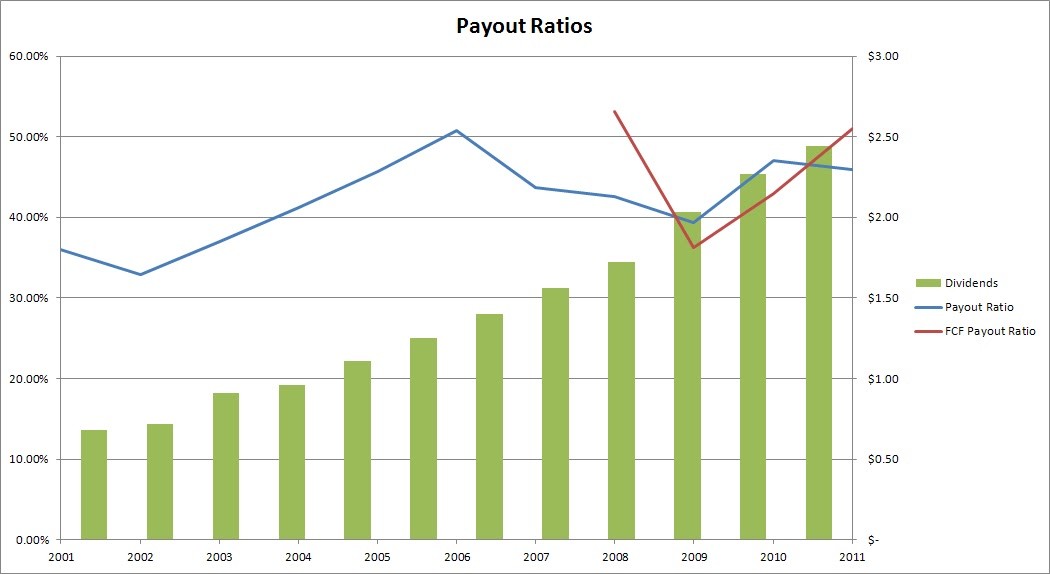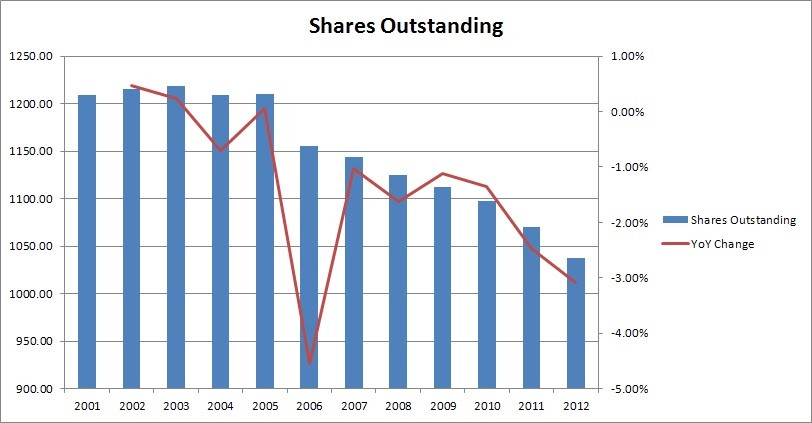Passive Income Pursuit Stock Valuation Method Discounted Cash Flow
Post on: 29 Апрель, 2015 No Comment

Monday, April 22, 2013
Stock Valuation Method — Discounted Cash Flow
This is the 5th part of my stock valuation series and I’ve previously covered the Graham Number. average dividend yield. average price-to-earnings ratio. and average price-to-sales ratios. The previous 4 posts all looked at a historical trends but didn’t really look into the future which is what we’re interested in. This week we’ll take a more in depth look at the discounted cash flows of the earnings for a company. Forgive me now, but this post will be a bit long and quite dry. Such is the nature when talking math. All my fellow math nerds though, enjoy.
Essentially a discounted cash flow analysis takes the future cash flows, or earnings per share, and discounts them back to now to get a net present value. Discounting is just the opposite of a growth rate. It’s a way to calculate how much money you would need now to have a certain amount in the future if you can compound it at the specified discount rate. The formulas in this are all very simple and it’s easy to create a spreadsheet to do all the work for you. The basic formula we’ll use is:
Formula 1
where FV = future value, PV = present value, GR = growth rate, and N = number of years
For example, if I offered to give you $1,000 a year from today, how much would you accept today so you had the same $1,000 in the future? If you assume that you can grow whatever dollar amount you receive by 10% in one year, then you would need me to give you at least $909.09 today to have $1,000 one year from now. How did I come up with the $909.09? Just rearrange the above formula to solve for PV. The formula becomes:
Formula 2
If you plug in FV = $1,000, GR = 10% = 0.10 and N = 1, the PV is calculated to be $909.09.
The Guts:
Now that the basics are out of the way, let’s go through the whole discounted cash flow process. First off, let’s figure out all the information we’ll need and define a few more terms. We need to figure out the starting EPS value to use. You can use the TTM EPS or the current fiscal year estimate. Next, we need to figure out what kind of growth rate to use. For simplicity, I use the analyst estimate for the next 5 years, although that’s subject to debate as to whether that should be used. If it’s a small or mid cap company that has a higher expected growth rate then I would expect a higher EPS growth rate, for large blue chip companies such as JNJ. PG. KO. CLX and the like, I would expect growth rates in the 5-10% range for the next 5-10 years. Next come up with a safe assumption for how long that growth can last. Typically I won’t use more than 5 years for my growth rate before swapping to the perpetuity rate.
Speaking of perpetuity rate, what is that? It’s just the expected EPS growth rate every year afterwards. I would safely expect that the companies mentioned above can at least grow EPS at the rate of inflation, which in the long-term has been around 3.50%. The last bit of information we need is the discount rate. As covered earlier, the discount rate is essentially your required rate of return. This is the value that every dollar of earnings will be discounted every year to calculate the net present value of those earnings. Some people like to use the risk free rate of return which is typically taken as the rate of the 10 year US Treasury bond, although I prefer to use a discount rate closer to 10% since this is a built in margin of safety and why would you take the risk of equity ownership if you can get a guaranteed return from T-bills.
Since we now have all of the inputs I’ll go over the steps. Take the starting EPS figure that you came up with and using formula 1 from above input the growth rate and EPS to calculate the FV EPS using N = 1. This gives you the future year’s EPS based on your expected growth rate. Now to calculate the NPV we swap over to formula 2 from above. Input the FV that you just calculated and use the discount rate as the GR in the formula with N = 1. Now you have the 1st year’s net present value, or discounted value.
To calculate the 2nd year, use formula 1 from above, but instead of the starting EPS you’ll use the FV EPS that you calculated in the previous step for year 1. Once you calculate the 2nd year EPS, swap back to formula 2 using the same discount rate except this time N = 2.
Repeat this process until you get to whatever year you want to crossover from the initial growth rate to the perpetuity or long-term growth rate. Once you get to that year, then start using the long-term rate instead of the higher growth rate for formula 1. Nothing changes in the process for formula 2 however. You then repeat the steps for several years, I’d go at least 30. Adding up the NPV of the EPS will give you the fair value price of the stock. If you pay no more than the fair value price and the EPS growth rates play out like you estimated, assuming a constant P/E ratio you would grow your investment at the discount rate or expected rate of return.
An Example
Our inputs will be Starting EPS of $1.00, 9% growth rate for 5 years, followed by 4% in perpetuity, with a discount rate of 10%.
(1) Calculate the FV EPS for Year 1 using Formula 1. FV = $1.00 * (1+0.09)^1 = $1.09
(2) Calculate the NPV of the Year 1 FV EPS using Formula 2. PV = $1.09 / (1 + 0.10)^1) = $0.99
(3) Calculate the FV EPS for Year 2 using Formula 1. FV = $1.09 * (1+0.09)^1 = $1.19

(4) Calculate the NPV of the Year 2 FV EPS using Formula 2. PV = $1.19 / (1 + 0.10)^2 = $0.98
Continuing these steps for 30 or more years and then summing up the NPV EPS = $21.42.
This means that $21.42 is the most you should pay per share of the stock in order to have a 10% rate of return.
Since I’m so nice, I’ve created a Google spreadsheet to calculate the Discounted Cash Flow for you guys to make your life easier. All you need is the same inputs from before, but the spreadsheet will calculate everything else, including using different discount rates with the same inputs. Feel free to look at the spreadsheet and try it out for yourself. All calculations should be protected but you can save the spreadsheet to your own Google drive if you want to make changes to the spreadsheet. If you happen to notice something that isn’t quite right or it won’t let you input your data, please let me know.
Conclusions:
A Discounted Cash Flow Analysis is great for several reasons. One being that it’s forward looking as opposed to backward looking. The previous methods that have been covered look at historical trends, however there’s nothing written in the rules of investing that says a company must continue to trade in its’ historical ranges for P/E, dividend yield, or P/S. Another thing I like about the Discounted Cash Flow analysis is that it allows you to see how fast a company must grow to be supported by the current share price. Just use the spreadsheet and change the inputs until the fair value price for your chosen discount rate equals the current price.
Like any valuation method, there’s limitations. For one, trying to forecast earnings per share into the future is a tough task from year to year, let alone decades into the future. The calculations are also very sensitive to the inputs. In the example used above, using an 11% discount rate changes the fair price to $18.30, a 14.5% lower price. While using a 9% discount rate changes the fair price to $25.80, a 20.4% higher price. Changing any of the inputs by small amounts can drastically change the fair value price. This leads to the garbage in, garbage out conundrum. If your assumptions for the inputs are way off base, then your fair price will be useless.
Is using earnings per share the best route to go with the discounted cash flow? Ideally you’d start with revenues and subtract the capital expenditures to determine the actual free cash flows. However all we can go off of is the historical norms for revenue growth, tax rates, capital expenditures, and depreciation. That just introduces more variables to make assumptions on, which introduces more sources for error. There’s just too many variables to try and make assumptions, a company’s tax rate my significantly change, a new unforeseen product could be introduced or any other number of changes. Using EPS is a good enough metric for me when calculating the discounted cash flow for its simplicity.
For all of the inputs I try to be pretty conservative in my growth rate estimates to have a built in margin of safety in the calculations. If I was going to use the discounted cash flow analysis as my main valuation method, I’d further decrease the final value by at least 15% to have additional margin of safety due to the limitations listed above. Remember, in the end we’re trying to forecast the growth of a company over several years using assumptions, and you know what the say about when you assume. A discounted cash flow analysis works best for large-cap stocks where you can have a higher degree of confidence in their yearly growth. I think it’s pretty safe to say that almost all of the consumer staple giants will be able to at least grow earnings on par with inflation over the long term.
Once again, no valuation method can possibly encompass everything about a company to determine a fair value. This is why I like to look at several different valuation methods to come up with a fair value price and to be able to compare across multiple methods. If all of the valuation methods I’ve covered show that the company is undervalued, then there’s a much better chance that it truly is undervalued.














